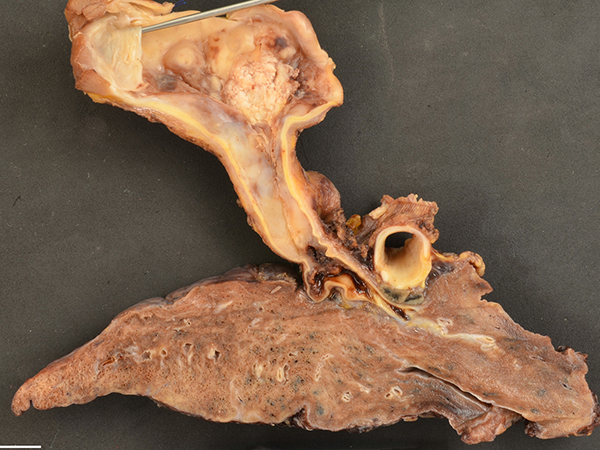Click here to see all images
May, 2021
Case of the Month
Clinical History: A 60-year-old woman presented with increasing shortness of breath and was found to have a pulmonary embolism that did not improve with anticoagulation. Imaging demonstrated an infiltrative pulmonary artery mass. A pneumonectomy was performed along with resection of the pulmonary artery and a portion of the right ventricle. The gross and microscopic findings are depicted in Figures 1-6. Note: Non-relevant clinical history may have been omitted or altered to protect patient privacy.
Quiz:
Q1. What is the most common histologic pattern in a pulmonary artery intimal sarcoma?
- Undifferentiated pleomorphic sarcoma
- Osteosarcoma
- Chondrosarcoma
- Rhabdomyosarcoma
Q2. Which gene has been reported to be frequently amplified in pulmonary artery intimal sarcomas?
- MYC
- MDM2
- HER2
- EGFR
Q3. Which of the following is a low-grade sarcoma that can present as a pulmonary artery intimal sarcoma?
- Rhabdomyosarcoma
- Osteosarcoma
- Pulmonary myxoid sarcoma
- Inflammatory myofibroblastic sarcoma
Answers to Quiz
Q2. B
Q3. D
Diagnosis
Discussion
These tumors can occur in patients across a large age range and often present with dyspnea and findings in keeping with chronic thromboembolic disease that is resistant to treatment with anticoagulation. Some studies suggest that incidental pulmonary artery sarcomas can be identified in 1-4% of thromboendarterectomy specimens from patients with chronic thromboembolic disease. As in this case, there may be areas of hemorrhagic infarction downstream from the main lesion (Figure 6).
The clinical outcome of pulmonary artery intimal sarcomas largely depends on the ability to completely resect the tumor. The 3-year survival is 70% in resected cases but the median survival is less than 1 year for tumors that are incomplete resections or inoperable.
Take home message
Pulmonary artery intimal sarcoma is a rare malignant neoplasm of the pulmonary artery that can present as chronic thromboembolic disease and is most commonly classified as an undifferentiated pleomorphic sarcoma.
References
Bode-Lesniewska B, Zhao J, Speel EJ, et al. Gains of 12q13-14 and overexpression of mdm2 are frequent findings in intimal sarcomas of the pulmonary artery. Virchows Arch 2001;438:57–65.
Tavora F, Miettinen M, Fanburg-Smith J, et al. Pulmonary artery sarcoma: a histologic and follow-up study with emphasis on a subset of low-grade myofibroblastic sarcomas with a good long-term follow-up. Am J Surg Pathol 2008;32:1751–61.
Contributors
Assistant Professor of Pathology
Department of Pathology and Laboratory Medicine
Western University
London, Ontario, Canada
Keith Kwan MD, FRCPC
Associate Professor
Department of Pathology and Laboratory Medicine
Western University
London, Ontario, Canada

